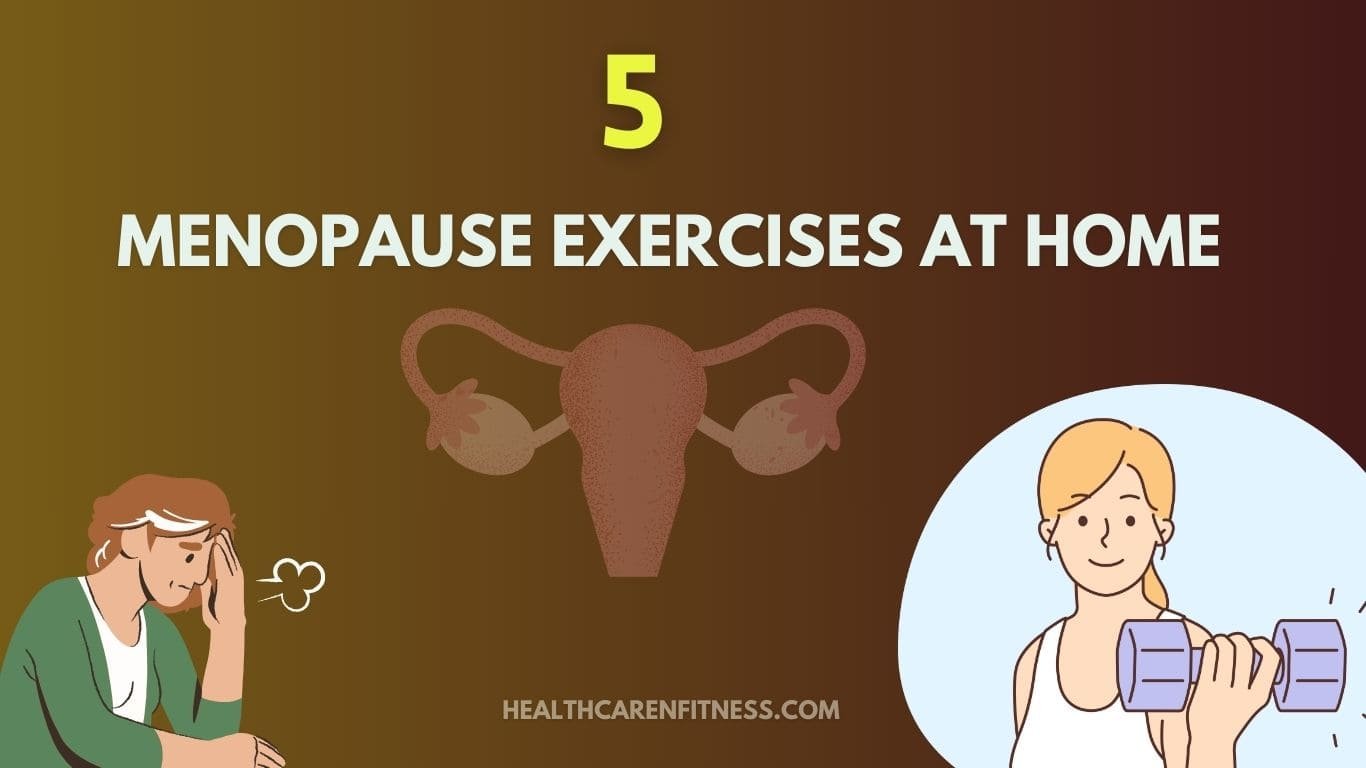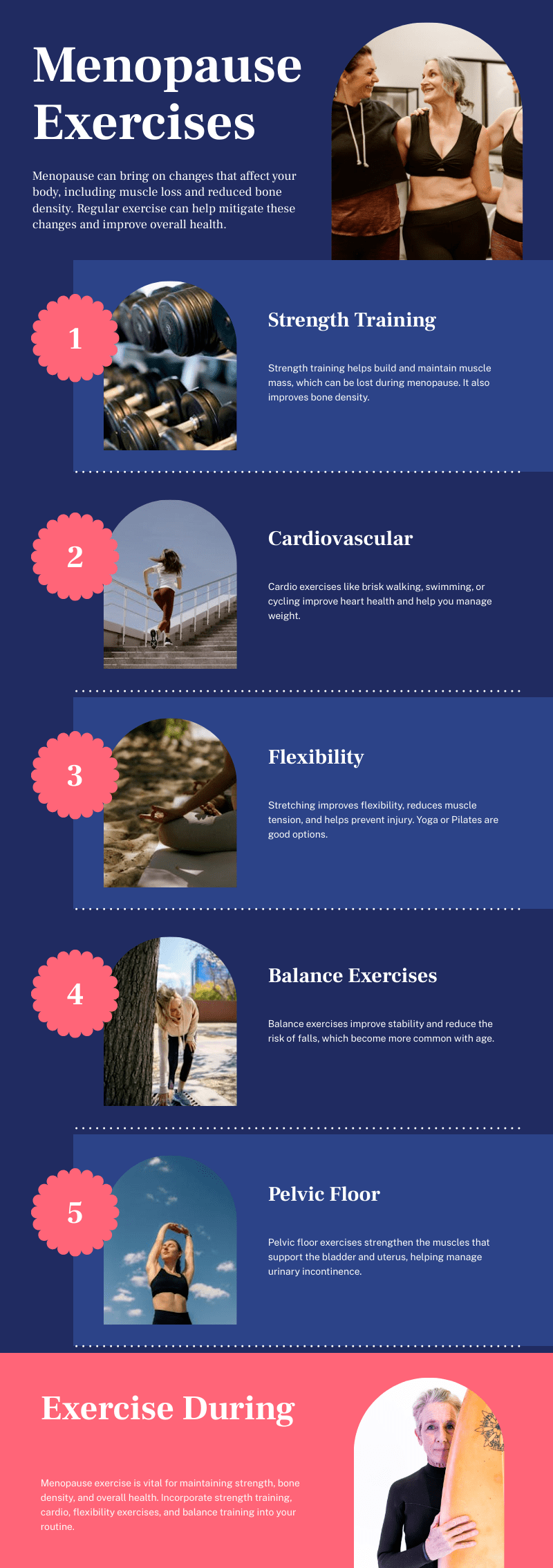
Menopause is a natural stage in a woman’s life, marking the end of her reproductive years. While it brings hormonal changes that can cause symptoms like hot flashes, weight gain, and mood swings, regular exercise can help manage the effects. The good news is that regular menopause exercises at home can help you manage its symptoms, boost your health, and regain confidence in your body.
In this guide, we’ll look at what happens during menopause, the most effective menopause exercises, their benefits, and how they can address common menopause-related issues, like belly fat and muscle loss.
What Happens to a Woman in Menopause?
Menopause is defined as the time when a woman no longer has a menstrual cycle for 12 consecutive months, usually between the ages of 45 and 55. This period marks the end of the menstrual cycle and the end of fertility. During this phase, the ovaries slowly reduce the production of estrogen and progesterone, resulting in symptoms such as:
- Irregular periods
- Hot flashes and night sweats
- Mood changes and sleep disturbances
- Weight gain, especially around the abdomen
- Reduced bone density and muscle mass
- Changes in heart health and metabolism
These changes can last from two to eight years, and the severity and duration of symptoms vary from woman to woman.
When Does Menopause Start for Most Women?
The menopause transition, known as perimenopause, typically begins in women between the ages of 45 and 55, with the average age of menopause being 51 to 52. However, factors such as genetics, lifestyle, and ethnicity can influence when it occurs. Premature menopause occurs before age 45, while early menopause occurs before age 40. However, staying active with menopause exercises at home can ease this transition.
5 Best Menopause Exercises at Home
You don’t have to join a gym to enjoy the benefits —menopause exercises at home are effective, accessible, and easy to fit into your daily routine. Following are the most effective exercises:
1. Strength Training
Benefits: Strength training helps build muscle mass, boosts metabolism, supports bone health, and helps reduce belly fat.
- Squats
- Lunges
- Push-ups (wall, knee, or full)
- Dumbbell shoulder presses
- Deadlifts (with proper form)
Aim for 2-3 sessions per week, targeting all major muscle groups.
2. Aerobic/Cardio Exercise
Benefits: It helps with heart health, helps burn calories and also manages weight.
- Brisk walking (indoors or outdoors)
- Dancing
- Cycling (stationary or outdoor)
- Low-impact aerobics
- HIIT (High-Intensity Interval Training) for advanced fitness
You should perform these activities for at least 150 minutes at moderate intensity weekly.
3. Core and Balance Workout
Benefits: It strengthens your core, improves posture and reduces the risk of falls.
- Planks
- Bridges
- Pilates routines
- Tai chi or yoga balance poses
4. Flexibility and Mind-Body Exercise
Benefits: It relieves joint stiffness, promotes relaxation and helps manage stress.
- Yoga (gentle or restorative)
- Stretching routines
- Pilates
- Deep breathing exercises
5. Pelvic Floor Exercises
Benefits: Promotes bladder control and sexual health.
Practice Kegel exercises, contracting and relaxing the muscles of the pelvic floor. Try to do several sets a day.

Sample Menopause Workout Plan at Home
| Day | Workout Type | Exercises | Duration |
|---|---|---|---|
| Monday | Strength Training | Squats, Push-ups, Plank | 20-30 mins |
| Tuesday | Cardio | Brisk Walking/Jogging | 30 mins |
| Wednesday | Yoga | Child’s Pose, Cat-Cow | 20 mins |
| Thursday | Core Workout | Bicycle Crunches, Leg Raises | 20 mins |
| Friday | Strength Training | Lunges, Glute Bridges | 20-30 mins |
| Saturday | Rest or Light Stretching | – | 10-15 mins |
| Sunday | Low-Impact Cardio | Swimming/Cycling | 30 mins |
Best Strength Training Exercises for Menopause
Focusing on compound movements is key. Here are the top picks for menopause exercises at home:
- Squats: Enhance the strength of your legs, glutes, and core.
- Lunges: Enhance balance and strengthen the lower body.
- Deadlifts: Develop strength in the back, glutes, and hamstrings (incorporate light weights or resistance bands).
- Push-ups: Sculpt the chest, arms, and shoulders (adjust as necessary).
- Shoulder Presses: Improve strength in the upper body.
- Rows (with Resistance Bands): Fortify the back and arms.
Perform 8-12 repetitions for each exercise, completing 2-3 sets, with a rest period of 1-2 minutes between sets.
Best Exercise for Menopause Belly Fat
Excess belly fat is a common problem during menopause, due to hormonal changes and a slow metabolism. An effective strategy includes:
- Resistance Training: Increases muscle mass, leading to increased calorie expenditure at rest.
- Aerobic Training: Helps burn calories and reduce overall body fat.
- High-Intensity Interval Training (HIIT): Consists of quick, intense activity followed by periods of rest; has been shown to promote fat loss and improve body composition.
- Core Training: Focuses on strengthening and toning the abdominal muscles.
FAQs
What happens to a woman in menopause?
Menopause is the time when a woman’s menstrual cycle stops permanently, ending her ability to have children. Lower hormone levels during this time can cause symptoms such as hot flashes, mood swings, weight gain, sleep disturbances, and changes in bone and heart health.
Can exercise reduce menopause symptoms?
Yes, exercise or physical activity helps control weight, improve mood, and reduce hot flashes.
When does menopause start for most women?
The majority of women start experiencing perimenopause in their late 40s, with menopause (defined as a full year without periods) generally happening around ages 51 to 52.
What are the best menopause exercises at home?
The best workout routine for menopause combines strength training, aerobic/cardio exercise, flexibility work (yoga, stretching), balance exercises (tai chi, Pilates), and pelvic floor exercises.
Should I avoid certain exercises during menopause?
If you have joint pain or problems, don’t do high-impact exercises. Low-impact cardio and strength training are better choices for you.
Conclusion
Maintaining an active lifestyle with menopause exercises at home can significantly improve your well-being during this stage. Whether it’s strength training, yoga, or cardio, maintaining a consistent routine is essential. Start slowly, pay attention to your body’s response, and gradually increase the intensity.
Incorporating these exercises into your daily life will help you cope with the symptoms of menopause, leaving you feeling stronger, healthier, and full of energy.
Did you find this guide helpful? Share it with other women going through menopause!
